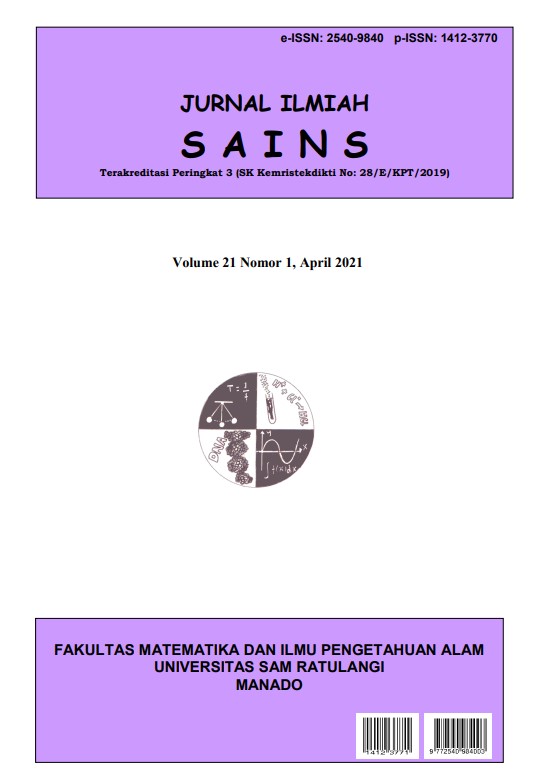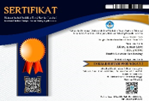Aktivitas Antioksidan Jus Stroberi (Fragaria ananassa Duchessne) Terhadap Kadar SGPT, SGOT dan MDA pada Tikus Jantan Galur Wistar yang Diinduksi Isoniazid
DOI:
https://doi.org/10.35799/jis.21.1.2021.30337Abstract
ABSTRAK
Isoniazid adalah obat anti tuberkulosis yang digunakan baik sebagai monoterapi atau kombinasi. Penggunaan isoniazid dalam waktu lama dapat menyebabkan hepatotoksik. Hepatotoksik disebabkan oleh hasil metabolisme isoniazid di hepar berupa hidrazin dan asetilhidrazin. Radikal bebas tersebut yang menyebabkan tingginya reactive oxygen species (ROS) didalam tubuh. Tingginya radikal bebas menyebabkan peningkatan kadar SGPT dan SGOT yang merupakan indikator adanya kerusakan hepar. Tingginya radikal bebas dalam tubuh dapat dilihat dari paramter MDA. Hal tersebut dapat diatasi dengan pemberian antioksidan eksogen seperti jus stroberi (Fragaria ananassa Duchessne). Tujuan penelitian ini untuk mengetahui skrinning fitokimia jus stroberi dan pengaruh pemberian jus stroberi terhadap kadar SGPT, SGOT dan MDA pada tikus yang diinduksi Isoniazid. Perlakuan diberikan  selama 14 hari dengan pembagian kelompok yaitu kontrol normal, kontrol negatif, kontrol positif, dosis 3g/kgBB, 6g/kgBB, dan 9g/kgBB. Pengambilan data dilakukan pada hari 1, hari 15, dan hari 29. Hasil penelitian dapat disimpulkan bahwa jus stroberi dapat menurunkan kadar SGPT, SGOT dan MDA pada tikus yang diinduksi isoniazid dengan dosis efektif sebesar 3g/kgBB tikus.
Kata kunci: Isoniazid; Â jus stroberi; MDA; SGPT; SGOT;
Effect of Strawberry Juice (Fragraria ananassa Duchessne) against SGPT, SGOT and MDA levels in Isoniazide-Induced Wistar Male Rats
Â
ABSTRACT
Isoniazid is an anti-tuberculosis drug that is used either as monotherapy or in combination. Prolonged use of isoniazid can cause hepatotoxicity. Hepatotoxicity is caused by the hepatic isoniazid metabolism in the form of hydrazine and acetylhydrazine. These free radicals cause high reactive oxygen species (ROS) in the body. The high level of free radicals causes an increase in SGPT and SGOT levels, which are indicators of liver damage. The high level of free radicals in the body can be seen from the MDA parameter. This can be overcome by giving exogenous antioxidants such as strawberry juice (Fragaria ananassa Duchessne). The purpose of this study was to determine the phytochemical screening of strawberry juice and the effect of giving strawberry juice on the levels of SGPT, SGOT and MDA in rats induced by Isoniazid. The treatment was given for 14 days divided into groups, namely normal control, negative control, positive control, dose of 3g / kg, 6g / kg, and 9g / kg of body weight. Data were collected on day 1, day 15, and day 29. The results of this study concluded that strawberry juice can reduce levels of SGPT, SGOT and MDA in isoniazid-induced rats with an effective dose of 3 g/kgBW rats.
Keywords: Isoniazid; Strawberry juice; MDA; SGPT; SGOT
References
Aaby, K., Ekeberg, D. & Skrede, G. 2007. Characterization of Phenolic Compounds in Strawberry (Fragaria x Ananassa) Fruits by Different HPLC Detectors and Contribution of Individual Compounds to Total Antioxidant Capacity. Journal of Agricultural and Food Chemistry, 55 (11): 4395–4406.
Aaby, K., Skrede, G. & Wrolstad, R.E. 2005. Phenolic Composition and Antioxidant Activities in Flesh and Achenes of Strawberries (Fragaria Ananassa). Journal of Agricultural and Food Chemistry, 53(10): 4032–40.
Agrawal, S. & Gupta, D. 2013. Assessment of Liver Damage in Male Albino Rats after Repetitive Heat Stress of Moderate Level. National Journal of Physiology, Pharmacy and Pharmacology, 3(2): 147–52.
Arifin, H., Anggraini, N., Handayani, D. & Rasyid, R. 2006. Standarisasi Ekstrak Etanol Daun Eugenia Cumini Merr. Journal Sains Teknologi Farmasi, 11(2): 88–93.
Arika, W.M., Nyamai, D.W., Osano, K.O. & Njagi, E.N.M. 2016. Biochemical Markers of In Vivo Hepatotoxicity. Journal of Clinical Toxicology, 6 (297).
Ayala, A., Mario, F. Munoz & Sandro, A. 2014. Lipid Peroxidation: Production; Metabolism; and Signaling; Mechanisms of Malondialdehyde and 4-Hydroxy-2-None. Oxidative Medicine and Cellular Longevity, 1–31.
Chen, J. & Raymond, K. 2006. Roles of Rifampicin in Drug-Drug Interactions: Underlying Molecular Mechanisms Involving the Nuclear Pregnane X Receptor. Annals of Clinical Microbiology and Antimicrobials, 5(3): 1–11.
Departemen Kesehatan RI. 1979. Farmakope Indonesia Edisi III. Jakarta: Departemen Kesehatan Republik Indonesia.
Departemen Kesehatan RI. 1995. Farmakope Indonesia Edisi IV. Jakarta: Departemen Kesehatan Republik Indonesia.
Endarini, L.H. 2016. Farmakognosi dan Fitokimia. Cetakan Pe. Jakarta: Badan pengembangan dan Pemberdayaan Sumber Daya Manusia Kesehatan.
Giknis, M.L.A. & Clifford, C.B. 2008. Clinical Laboratory Parameters For Crl:WI(Han) Rats. Charles River Laboratories.
Gülçin, I., Huyut, Z., Elmastaş, M., & Aboul-Enein, H.Y. 2010. Radical Scavenging and Antioxidant Activity of Tannic Acid. Arabian Journal of Chemistry, 3 (1): 43–53.
Hassnin, K.M.A. & Hashem, K.S. 2013. He Hepatoprotective Effects of Vitamin C and Micronized Vitamin C against Paracetamol Induced Hepatotoxicity in Rats: A Comparative Study. Journal of Veterinary Medical Research, 22(1): 46–52.
Hayati, E.K., Jannah. A. & Ningsih, R. 2012. Identifikasi Senyawa Dan Akktivitas Antimalaria In Vivo Ekstrak Etil Asetat Tanaman Anting-Anting (Acalypha indica L.). Molecules, 7(1): 20–32.
Kähkönen, M.P., Hopia, A.I. & Heinonen, M. 2001. Berry Phenolics and Their Antioxidant Activity. Journal of Agricultural and Food Chemistry, 49 (8): 4076–82.
Pillai, K.K., Chidambaranathan, N., Halith, M.M., Jayaprakash, S. & Narayanan, N. 2012. Hepatoprotective Activity of Cnidoscolus Chayamansa against Rifampicin and Isoniazide Induced Toxicity in Wistar Rats. Research Journal of Pharmaceutical, Biological and Chemical Sciences, 3 (2): 577–85.
Lian, Yong, Jing Zhao, Peiyu Xu, Yimei Wang, Jun Zhao, Li Jia, Ze Fu, Li Jing, Gang Liu, and Shuangqing Peng. 2013. Protective Effects of Metallothionein on Isoniazid and Rifampicin-Induced Hepatotoxicity in Mice. Plos One, 8 (8).
Miguel, M.G. 2011. Anthocyanins: Antioxidant and/or Anti-Inflammatory Activities. Journal of Applied Pharmaceutical Science, 1(6): 7–15.
Mitruka, B.M. & Rawnsley, H.M. 1981. Clinical Biochemical and Hematological Reference values in Normal Experimental Animal and Normal Humans. 2nd Ed. Year Book Medical Publisher Inc., Chicago. 81-83.
Momuat, L.I., Sangi, M.S. & Purwanti, N.P. 2011. Pengaruh VCO Mengandung Ekstrak Wortel Terhadap Peroksidasi Lipid Plasma. Jurnal Ilmiah Sains, 11(2): 296–301.
Nuria, M.C., Faizatun, A. & Sumantri. 2009. Uji Aktivitas Antibakteri Ekstrak Etanol Daun Jarak Pagar (Jatropha curcas L.) Terhadap Bakteri Staphylococcus Aureus ATCC 25923, Escherichia Coli ATCC 25922, Dan Salmonella Typhi ATCC 1408. Jurnal Ilmu Pertanian, 5 (2): 26–37.
Oszmiański, J., & Wojdyło, A. 2009. Comparative Study of Phenolic Content and Antioxidant Activity of Strawberry Puree, Clear, and Cloudy Juices. European Food Research and Technology, 228(4): 623–31.
Peanasari, A.R.I, Djamil, S.L. & Rohmani, A. 2015. Pengaruh Formalin Peroral Terhadap Kadar SGOT Dan SGPT Tikus Wistar. Jurnal Kedokteran Muhammadiyah, 2: 34–38.
Rahman, A.O., Jarir, A.T. & Mustofa. 2013. Association of hydrazine and SGPT level two hours after drug administration at the end of intensive phase treatment of pulmonary tuberculosis patients. TMJ., 2(2): 113-122.
Raj, V.P., Chandrasekhar, R.H., Vijayan, P., Dhanaraj, S.A., Rao, M.C, Rao, V.J. & Nitesh, K. 2010. In Vitro and in Vivo Hepatoprotective Effects of the Total Alkaloid Fraction of Hygrophila Auriculata Leaves. Indian Journal of Pharmacology, 42(2): 99–104.
Reynertson, K.A. 2007. Phytochemical Analysis of Bioactive Constituents from Edible Myrtaceae Fruits. University of New York.
Robinson, T. 1995. Kandungan Organik Tumbuhan Tinggi. ITB Press, Bandung.
Saraswati, T.R. 2015. Efek Pemberian Serbuk Kunyit Dalam Pakan Terhadap Hepar Puyuh Jepang (Coturnix Japonica). Buletin Anatomi Dan Fisiologi, 23(2): 94–100.
Untari, E.K., Wahdaningsih, S. & Damayanti, A. 2014. Efek Fraksi N-Heksana Kulit Hylocereus Polyrhizus Terhadap Aktivitas Katalase Tikus Stres Oksidatif. Pharmaceutical Sciences and Research, 1(3): 141–53.
Valko, Marian, Dieter Leibfritz, Jan Moncol, Mark T D Cronin, Milan Mazur & Joshua Telser. 2007. Free Radicals and Antioxidants in Normal Physiological Functions and Human Disease. The International Journal of Biochemistry & Cell Biology, 39: 44–84.
Witthawaskul, P, Ampai Panthong, D Kanjanapothi, T Taesothikul & N Lertprasertsuke. 2003. Acute and Subacute Toxicities of the Saponin Mixture Isolated from Schefflera Leucantha Viguier. Journal of Ethnopharmacology, 89: 115–21.
Wu, Yihang, Fang Wang, Qunxiong Zheng, Longxi Lu, and Hongtian Yao. 2006. Hepatoprotective Effect of Total Flavonoids from Laggera Alata against Carbon Tetrachloride-Induced Injury in Primary Cultured Neonatal Rat Hepatocytes and in Rats with Hepatic Damage. Journal of Biomedical Science, 13: 569–78.
Xu, Dong, Meng Jiao Hu, Yan Qiu Wang, and Yuan Lu Cui. 2019. Antioxidant Activities of Quercetin and Its Complexes for Medicinal Application. Molecules, 24(6).







